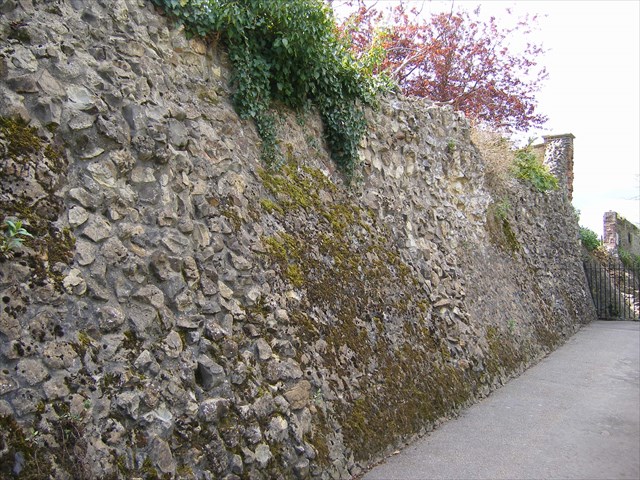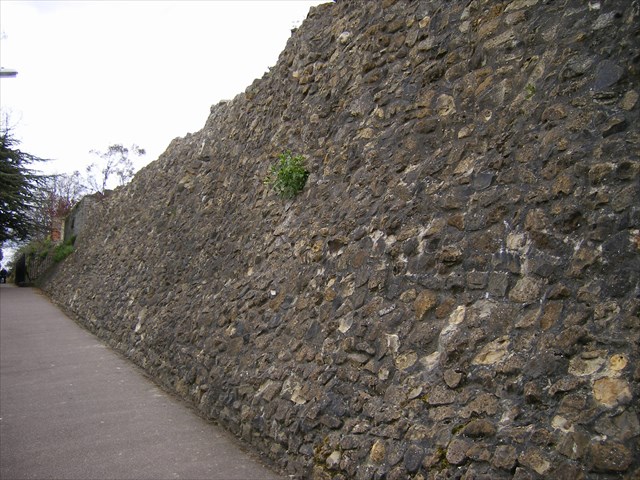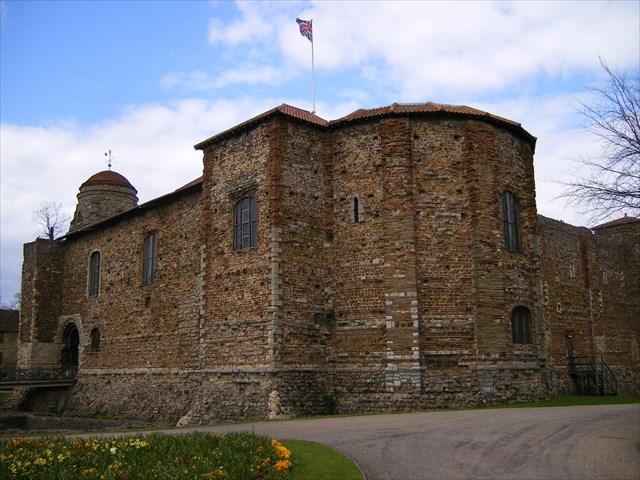Colchester Building Stone Tour: Septarian Nodules
This cache is all about sedimentary rocks and a large fossil imprint.
You are standing in front of the Roman wall which was built during the Roman occupation nearly 2000 years ago. The co-ordinates take you to a section of the wall. Much of the Roman wall and Colchester Castle is made of septarian nodules from London Clay. London Clay is a marine geological formation of Lower Eocene Epoch from ~56-49 Million years ago. Septarian nodules (also known as ‘septaria’) from the London Clay can be seen in old buildings in east Essex, particularly churches close to the coast. The Romans used septarian nodules extensively; one surviving example is Colchester’s Roman wall.

Roman wall looking towards Duncan’s Gate.

Roman wall looking towards Duncan’s Gate.
Another example of the use of septarian nodules as building material is the Norman castle at Colchester.

Colchester Castle
The nodules are claystone concretions named after their characteristic internal structure of radiating mineral filled cracks called 'septa'. The cracks are lined with calcite crystals. I have included two waypoints where there are really nice examples of the minerals. At N 51° 53.572 E 000° 54.335, in between the fossil and Duncan's Gate, there are some lovely examples of crystals inside the nodules.
At this part of the wall a nodule is broken and a fossil imprint is exposed. This is the only one I could find in the wall, but I have heard that there are several other fossil imprints in this stretch of the wall. Maybe you can find one?
The co-ordinates take you to an Ammonite fossil. Ammonites existed during the Triassic period till the end of the Cretaceous period ~251 to ~65 million years ago so these cannot be from the London Clay. Ammonites are long extinct marine animals that were named because their shape.

Artist's impression of what an ammonite may have looked like.
These septarian nodules must be different to other nodules in the wall. This specimen may have come from the Oxford Clay of the East Midlands; brought to Essex by the Anglian ice sheet. Oxford Clay is well known for its rich fossil record of fish and invertebrates. Animals which lived in the Oxford Clay Sea include plesiosaurs, marine crocodiles, ichthyosaurs, cephalopods (such as belemnites and ammonites), bivalves (such as Gryphaea), and a variety of gastropods. Dinosaur eggs have also been found in the Lower Oxford Clay.
This cache is 'placed' with the kind permission of Colchester Borough Council.
Please email me the answers to the following questions to claim this as a find:
1. Describe the fossil imprint.
2. Measure the fossil. How big is it in centimetres?
3. Nearby (a few feet to the right as you look at the wall) at N 51° 53.572 E 000° 54.335 there are some nice examples of the crystals that form inside these nodules. What colour are the crystals?
In keeping with recent changes to Earthcache rules, photographs are now optional and I cannot require these to be posted. A photo speaks a thousand words though, so if you have a nice photo of any combination of you, your GPSr and the wall I hope you will choose to post one to the cache page anyway!
Please email me the answers to questions 1, 2, and 3 and post your photo in your log. Please do not post the answers to questions 1, 2, and 3 in your log. Logs with this information in will be deleted.
